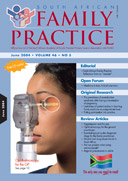Putting participation into practice.
Abstract
Background: The aim of the article is to share the findings of participatory action research performed to develop a mutual participatory doctor-patient relationship model, and to apply this model in a rural cross-cultural primary care setting. Method: Participatory action research was performed with four patient groups. Four patients with incurable illnesses formed groups with their family members and significant others. Seven monthly meetings with each group were audio recorded. The question asked at each meeting was “How can the group work together to achieve the best possible health outcome for the patient?. The recorded interviews were transcribed and translated from the local vernacular (Tsonga) into English. Themes were identified from the transcripts, field notes and a reflective diary. A list of combined themes was compiled and a model was constructed to depict the themes and their interrelatedness. The model was interpreted and conclusions were drawn. Results: To apply a mutual participatory model in a rural cross-cultural practice, the physician is required to operate from certain basic tenets. The patients have to participate actively to benefit optimally, and basic interviewing techniques are helpful to facilitate mutual participation. Conclusions: It is not easy to implement a mutual participatory model in a disadvantaged, rural practice, but it is possible. We need a paradigm shift in health care, from “helping patients (which may nurture dependence), towards facilitating the personal growth and development of patients (to nurture self-reliance). (SA Fam Pract 2004;46(5): 31-36)
Published
2004-06-01
Issue
Section
Original Research
By submitting manuscripts to SAFP, authors of original articles are assigning copyright to the South African Academy of Family Physicians. Copyright of review articles are assigned to the Publisher, Medpharm Publications (Pty) Ltd, unless otherwise specified. Authors may use their own work after publication without written permission, provided they acknowledge the original source. Individuals and academic institutions may freely copy and distribute articles published in SAFP for educational and research purposes without obtaining permission.

